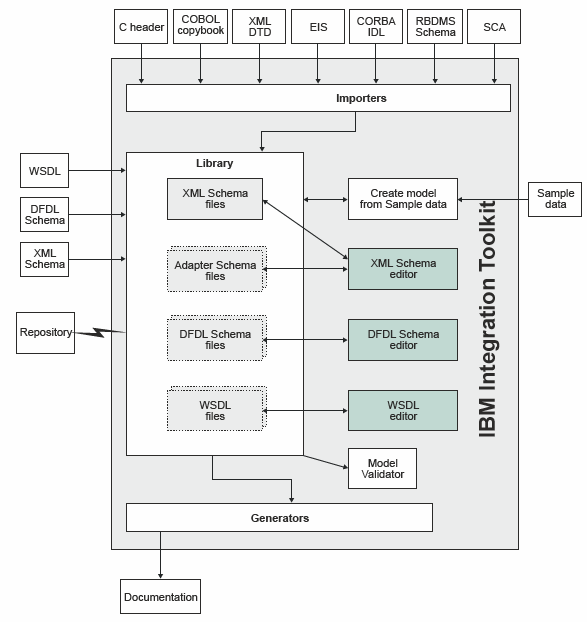Message modeling concepts
Message modeling is a way of predefining the message formats that are used by your applications.
Modeling your message formats is necessary for IBM® Integration Bus to understand some data formats, but simplifies the development of message flows regardless of the data format that you are processing. For a full description of the advantages of using message models, see Why model messages?.
- Message models
- Schema files
- Domains and parsers
- New Message Model wizard
- Model editors
- Model generators
- Model validator
- Message sets
For more information about applications and libraries, see Resource management overview. For a description of message sets, see Message Sets: Message sets overview. The remainder of this topic describes message model schema files.
The following figure shows the different types of files that comprise a message model in a library or application. It shows the formats that can be imported by using the New Message Model wizard.

A message model is used by IBM Integration Bus to model a message format. The message models used by IBM Integration Bus are based on W3C XML Schema.
| Format | Message model schema file |
|---|---|
| SOAP XML | XML Schema 1.0 and WSDL 1.0 |
| Other XML | XML Schema 1.0 |
| CSV | Data Format Description Language 1.0 |
| Other delimited | Data Format Description Language 1.0 |
| Industry standard text or binary data | Data Format Description Language 1.0 |
| Custom text or binary data | Data Format Description Language 1.0 |
| COBOL structure | Data Format Description Language 1.0 |
| C structure | Data Format Description Language 1.0 |
| PL/I structure | Data Format Description Language 1.0 |
| CORBA IDL | XML Schema 1.0 |
| SCA import or export | Message sets only |
| SAP | WebSphere Adapter Schema or message sets |
| Siebel | WebSphere Adapter Schema |
| PeopleSoft | WebSphere Adapter Schema |
| JDEdwards | WebSphere Adapter Schema |
| Database record | XML Schema 1.0 |
| JSON | The JSON parser does not use a model. |
| MIME | The MIME parser does not use a model. |
XML Schema 1.0 (XSD) is an open standard modeling language from the World Wide Web Consortium (W3C) that was designed to model and validate XML documents. However, it can also be used to express the logical structure of all data formats. For more information about XML Schema, see XML Schema.
Data Format Description Language 1.0 (DFDL) is an open standard modeling language from the Open Grid Forum (OGF) that builds upon the features of XSD 1.0 in order to model and validate all kinds of general text and binary data. It uses standard XSD model objects to express the logical structure of the data, together with DFDL annotations to describe the text or binary physical representation. For more information about DFDL, see Data Format Description Language (DFDL).
WebSphere Adapter Schema is an IBM extension to XSD 1.0. It uses the standard XSD model objects to express the logical structure of data, along with special annotations that are used when exchanging data with EIS systems that use the WebSphere Adapters of the integration node.
- o Using the XSD or DFDL editors in the IBM Integration Toolkit
- o Importing from other files (for example XML DTD or COBOL copybooks)
- o Generating a model from an example data stream (XML only)
- o Connecting direct to EIS systems or databases
When a message model schema has been created, it can be edited to refine the model. Specific editors are provided for XSD schema and DFDL schema. Adapter schemas are edited if necessary using the XSD schema editor. A WSDL editor is also provided. For more information about the available editors and their functions, see Editors.
A message model schema consists of a number of different model objects. For more information about message model objects, see Message model objects.
When your message model schemas are complete, you can use them in developing your message flow. For more information, see Why model messages??